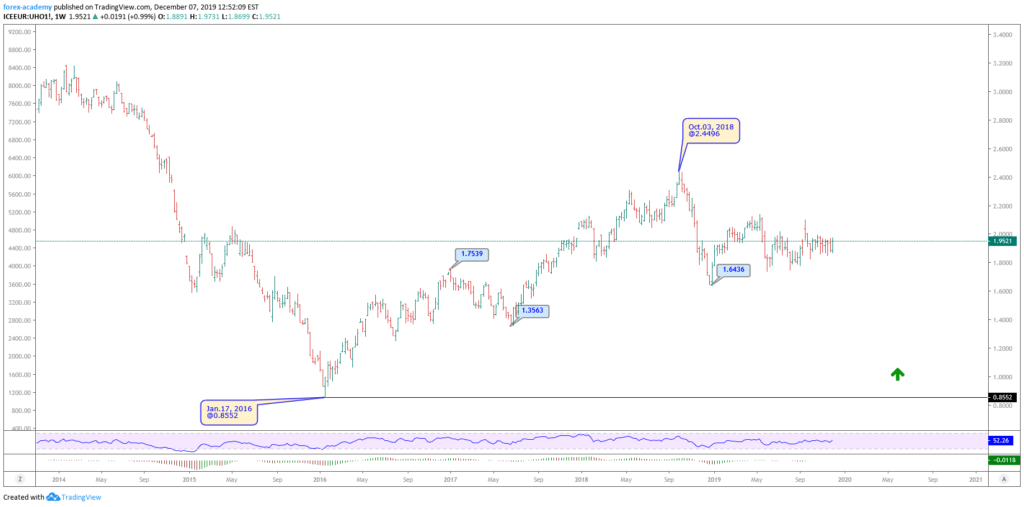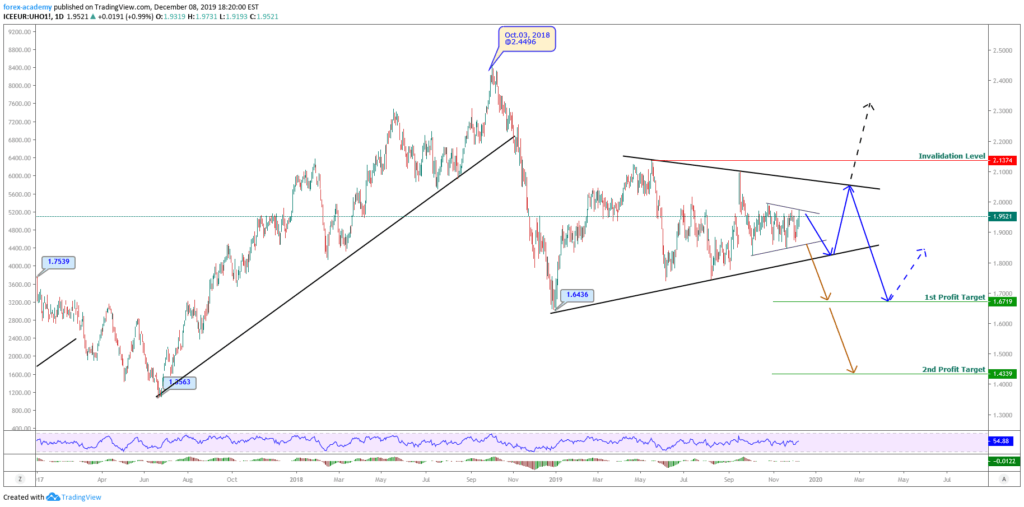Introduction
An essential “first step” for a trader who aspires to reach success is to fully understand how markets work, the deepest dynamics if you will. I.e., that certain tool or criteria that would allow him to decide whether or not to enter, and if so, at which price, as well as possible “escape” routes. There is something which novice participants struggle with, and it deals with the apparent chaotic randomness depicted by price, especially in short time-frames. In fact, visualising markets as a jungle with innumerable dangers, hidden pitfalls, and an overwhelming uncertainty would better clarify this point. Yet, traders need a map, and this article is about one possible way to draw it.
To succeed, participants must get rid of a frequent bias consisting in their belief that trading financial instruments is about keeping a high success rate on entries; moreover, a common mistake is to associate profits with earnings. You would be surprised at the following statistically-corroborated fact: while frustrated retail traders reach, on average a success rate of up to sixty-five percent (65%), consistent professional ones barely overtake the bar of twenty-five percent (25%)! That is possible because trading is not gambling. After all, trading is not about gambling; instead, the two critical elements involved are accuracy when entering the markets and the risk-reward ratio.
Thus, a given methodology can be profitable even with success rates as low as ten percent (10%) when holding a risk-reward ratio of over than 10 to 1. That shows that we don’t need to predict the market. The real secret is to search and find situations where we could detect a high reward to risk ratio. On a reward to risk of N, we just need to be successful once every N trades. That’s a fact. Undertaking the risk-reward ratio as the filtering criteria is the trick towards successful trading, i.e., discarding scenarios with low ratios to protect us when dealing with losing streaks. After all, if the odds turn against us while keeping a high ratio as hardcore in our analysis, all we have to do is to wait for the tides of prices change back in our favour.
Going back to our jungle and map metaphor, Elliot Wave Theory, coupled with Fibonacci retracements and extensions serve as a framework of reference when applying our preferred trading methodology, and filter setups with an optimal combination of success rate and risk-reward ratio. We must warn the reader that our approach to The Elliott Wave Theory will not be conventional. Just like it is often introduced as a “crystal ball” with magical forecasting properties, we shall focus on those features oriented towards the achievement of more suited setups, entries and targets from a risk-reward ratio standpoint.
For those who wish to deepen their knowledge of more advanced Elliot principles, we’ve included a bibliography section at the end of this article.
The basics of the Elliott Wave Principle
The basis of the Elliott Wave analysis is this: The market moves in a fractal pattern of waves, but the basic model is formed by an impulsive wave and a corrective wave, which, at its end, marks the beginning of another impulsive wave.

Within this idealised Elliott world, the impulsive phase is a pattern of five waves. Three of them have an impulsive nature and two have corrective.
The corrective wave pattern is composed of 3 waves, two impulsive and one corrective. Elliotticians identify them by using letters.
N.R. Elliott observed that wave patterns form larger and smaller versions of the main wave pattern. This repetition means that price behaves in a fractal manner. By keeping the wave count, traders can identify how old the current trend is and the likely place when a new one begins.

Points about Elliott Wave Analysis that helps in trading:
- Identifying the main trend direction.
- Visualising counter-trend legs.
- Determining the trend maturity.
- Defining potential targets.
- Specific invalidation points.
Identifying the main trend and why is it important
Impulsive waves are the easiest to trade. It’s the path of least resistance, and where reward to risk is highest. Corrective segments are hard, with a lot of volatility and noise, because it’s a place where bulls and bears fight to take control of the price. Fig 5 shows a risk to reward study on both waves, on a EUR/USD daily chart, from March to August 2015. We observe that corrective waves are noisy, with limited rewards for the risk. Impulsive waves are exuberant and optimistic, this is where we can optimise this ratio. Therefore, it’s wise to trade with the trend.
Identification of the primary trend is quite straightforward: It’s the direction pointed by one or several previous impulsive legs, in the case of Fig 5 it’s obvious we are at an uptrend.

Visualisation of Countertrend Legs
Corrective segments are places of recess from the impulsive phase. The impulse has travelled too far, according to the participants, and some of them take profits, while others sell short.
But, corrective waves are continuation patterns. Therefore, a C wave edge identifies a place of low risk and high reward to start trades aligned with the primary trend. Examples of what I mean is the end of c waves in Fig 5 that signals the beginning of a new and tradable impulsive pattern in the main trend direction.
Trend maturity determination
As we observe in Fig 4, market waves form wave patterns within wave patterns in a continuous fractal fashion. We see that wave [1] subdivides into five small waves. Therefore, we can identify the maturity of prices by looking at where they are on the wave map.
Definition of price targets
Price target assessment is done using Fibonacci ratios and one to one projections in rising channels.
Fibonacci and projections will be discussed later in more depth. On Fig 6 we see a projection example using the same EUR/USD chart from Fig 5. The line from C to 1 is copied and projected in wave 3, starting at the end of wave 2. The length and angle are unchanged. The same projection is repeated (because wave 3 ended just as forecasted by that line) to find the end of the 5th wave. In that case, we noticed that this wave had an over-extension and this projection fell short.
The same operation can be performed on corrective waves. On Fig 6 we see an example to forecast the end levels and times of wave 4 by projecting the line drawn on wave 2.

Specific invalidation points
Knowing when the trade scenario is no longer valid is the most critical piece of information a trader needs. The wave rules give specific levels at which that scenario has failed and when the count is invalid.
Specifically, three rules help us find those invalidation levels.
- Wave 2 can never retrace more than 100% of wave 1.
- Wave 4 should never end beyond the end of wave 1.
- Wave 3 can never be the shortest.
A violation of these rules implies that the wave count is invalid. That will help us determine if the trade has a reward worth its risk, even before entering the trade. We should avoid less than 1:1 reward-to-risk ratios, as we have discussed in the introduction to this article.
The most profitable waves to Trade
As we have discussed before, the most profitable waves are impulsive, because they are following the direction of the primary trend.
And which waves of the total Elliott cycle are impulsive?
- They are waves 1, 3, 5, A and C. Waves 2, 4 and B are corrective.
Particular care should be taken when trading wave 1 since the latest wave was an impulsive wave in the opposite direction, so the pattern of trend change hasn’t been established, and, usually, wave 2 corrects almost 100% of its gains. Therefore, it’s better to wait until the end of a wave 2 pullback than risking too early on a wave 1 wannabe.
We should remember that a five-wave pattern determines the direction of the main trend, while a three-wave pattern is an opportunity to join the trend.
Hence, the final count for profitable trading following the main trend are waves 3, 5, A and C.

Fig 7 shows the Elliott Wave setups. To the left, the bull market setups, while to the right the bearish market version.
As seen above, these setups, except at the end of wave 5, are entries on the main trend pullbacks, at the end of corrective waves. That makes sense because we know that impulsive waves depict much higher rewards for its risk. The second consideration is that at the end of these waves we achieve our goal to optimise the risk-reward of trades. Therefore, at least theoretically, they are as perfect an entry as they may possibly be.
Important methodology to profit from the Elliott Wave
The first rule has been already said: Trade with the trend. Just trade when a primary trend has been established.
The second rule is, let the market show you a confirmation, for example, a price breaking a strategic high or low, price breaking out of a triangle formation and so on.
The third rule has already been mentioned: We are business people. Therefore, we should seek a proper reward for our risk. We have already mentioned the importance of high reward-to-risk ratios. A ratio of 3 allows us to be profitable with just one good trade every three trades.
Let’s do an exercise. Suppose a trader has 70% success on their trades and has a reward-to-risk ratio of one. Let’s call that risk R.
After ten trades, they have won 7R and lost 3R, for a total profit of 4R.
Now suppose, we plan not to take profits so soon. For reward-to-risk ratios of 3:1, and as a consequence, we end with 40% profitable trades. Let’s do the maths:
Total profitable trades: 4 -> total profit: 3X4R= 12R
Total unprofitable trades: 6 -> total losses: 6x1R = 6R
Total Profit on ten trades = 6R
Therefore, the conclusion is clear: by planning to get 3:1 reward-to-risk ratios we are 50% more efficient, even though we decrease our hit rate by 42%. Thus, traders should take care of this primary aspect of a trade and not accept trades with less than 2:1 ratios.
Impulsive waves
The standard technique is to enter on a break of the high or low of the lower order 5th wave. This breakout defines a point of invalidation of the current trend because the last low or high has been broken.
Fig 8 shows the complete entry setups for longs and shorts. We see that the entry is executed at a breakout of wave [v] to the upside/downside, invalidating the current trend, as it failed to make new lows/highs.

Bull and bear Diagonals
According to Frost and Prechter, a diagonal is a motive pattern, but it cannot be qualified as an impulse because it holds corrective characteristics. It’s a motive because its retracements don’t fully reach the preceding sub-wave, and the third sub-wave is never the shortest. However, diagonals are the only five-wave structures in which its fourth wave moves into the price area of wave 1, and its internal waves are three-legged structures. This pattern substitutes an impulse at the corresponding location.
Ending Diagonal
An ending diagonal is a substitution of the fifth wave, usually, when the preceding move has gone too far and too fast, according to Elliott. A small percentage of diagonals appear in C-waves also. These are weak formations. According to Frost and Prechter: “Fifth wave extensions, truncated fifths, and ending diagonals all imply the same thing: dramatic reversal ahead”.
There are three ways to set up a trade on ending diagonals. The first and most conservative is to wait for the break of wave four extreme Fig 9 – (2). You gain precision at the expense of reward-to-risk ratio. You could improve that ratio by entering the trade at (1) at the breakout of the diagonal trendline connecting 2 and 4. The third way is a combination of the former two. You start taking a fractional position at (1) and, then add to the position when it breaks levels at (2).

Trading corrections
Markets movements against the primary trend are fights between those who think that the trend is over and those that see a pullback as an opportunity to jump into the trend. This struggle makes corrective patterns a dangerous and unproductive place. My advice to inexperienced traders is not to trade corrections until you get extensive knowledge about how a particular market behaves. This market phase is like to a river crowded with thousands of crocodiles. You may be lucky and cross the river, but you’re risking losing one leg or both.
A corrective phase is more complex than an impulsive phase; it unfolds slowly and depicts a noisy, random, path, taking diverse shapes such as flats, triangles zigzags or a combination. They are erratic, time-consuming, and misleading.
There are situations where the channel within which the corrective wave moves is wide enough so that the potential reward is high enough. Under those circumstances, it may be beneficial to move to a shorter timeframe to detect the right entry points.
Corrective processes show two classes. Sharp corrections and sideways channels. No more explanation needed. Sharp corrections move prices to correct a substantial part of the movement of the main trend, while sideways channels depict lateral movement that, while moving prices back the from the previous trend ending, it contains legs that carry price back to, or even beyond its initial level producing a kind of lateral channel.
There are three main categories: Zigzags, Flats and Triangles.
ZigZags
A single zig-zag in a bull market is a simple three-wave (A-B-C) pattern that pulls back some of the gains of the primary trend (fig 10, left side). In bear markets, corrections are a kind of bear traps that drive prices up in the opposite way (fig 10, right side).

On occasions, double or triple zigzags occurs. In that case, according to Frost and Prechter, zigzags are separated by an intervening “three”. These formations, still according to Frost and Prechter, are analogous to the extension of an impulse wave but are less common.

Zigzag setups for bull and bear markets are shown in Fig. 12. These setups profit from an entry at the extreme of a c-wave and assuming this is the conclusion of the correction and that a new wave in the direction of the main trend is starting.
We have three ways to trade that, as happened in ending diagonals. The more aggressive style, presenting the best reward for its risk, is taking the trade at point (1) of fig 12, which corresponds to the breakout of the [iv] sub-wave. A more conservative approach is to wait for the breakout of the [c] wave, which also corresponds to the extreme of wave B (Fig. 12, point (2)). Finally, we could take a medium-risk approach by opening with a fraction of the total risk at (1) and take the rest at (2).

Flats
A flat is a correction that differs from a zigzag in that its sequence is a 3-3-5 wave. The reason is that the first wave A lacks the strength to create five sub-waves. Then B-wave finishes near the starting of A and then C, having five sub-waves that generally, ends slightly below A, almost drawing a double bottom or top.

The final wave of a flat wave is a 5-wave pattern. Therefore, we can apply the setup used for the 5th wave (Fig. 8). That means trading the breakout of the [iv]sub-wave. Fig 14 shows the configuration for bull and bear markets.

Triangles
A triangle is a price pattern reflecting doubts and a balance of opinions between market participants. This pattern subdivides into 3-3-3-3-3 sub-waves, labelled A, B, C, D, and E. A triangle is outlined when connecting A and C, and B and D. It’s usual for Wave E to undershoot or overshoot the A-C line.
There are three triangle varieties: Contracting, barrier and expanding.

The safest entry waits for wave [c] wave to be broken. More aggressive entries are not recommended because triangles are very deceptive, and sometimes some formation that seems a bullish continuation pattern actually could become a bearish triangle.

This completes this basic guide to Elliott Wave trading. In upcoming articles, we will examine real chart examples of the setups sketched out in this document.
References:
Visual guide to Elliott Wave Trading, Wayne Gorman
Elliott Wave Principle: Key to Market Behavior, Robert R. Prechter Jr.; A. J. Frost.
© Forex. Academy



































